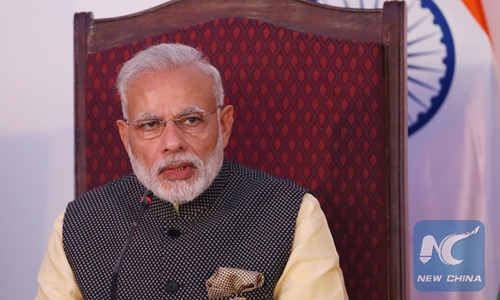
Indian Prime Minister Narendra Modi Photo: Xinhua
The Modi government deserves some credit for attempting to push ahead with its largest privatization program in more than a decade. The sale of majority stakes in India's state companies is said to be part of its reform effort, with the aim of raising funds to reduce the budget deficit, as well as luring foreign investment and boosting its economy.This is not the first time that the Modi government has rolled out reforms aimed at privatizing state-owned companies, which will have a positive impact on the Indian economy in the long run despite the current challenges and resistance.
Yet, the path of reform will not be easy for India, which aims to build the country into an attractive manufacturing destination for foreign businesses. Manufacturing competitiveness cannot be simply improved by selling stakes. Market opening-up is also essential but implementation in this regard is far from simple.
While some say that India's economy has greater openness than China's, there is a huge gap between China and India when it comes to attracting foreign investment. That's not determined just by opening-up policies - it also requires other supporting factors like infrastructure, logistics and the quality of the labor force. In 2018, foreign direct investment (FDI) in India reached $42 billion, while China received FDI worth a record $139 billion, according to a UN report released in June.
India's latest privatization efforts just mark an important step toward its opening-up goal. There is still far to go when it comes to improving its industrial manufacturing ability. It's no secret that problems with its tax policies, land system and labor issues have always been considered the key factors restraining the country's economic reform and development. Implementation of any unified reform is difficult due to the country's demographic and political diversity.
What is happening in India also occurred in China decades ago. Take the textile industry as an example. When China took a full-scale opening-up approach to its textile sector, businesses from developed countries and regions began to enter China, bringing capital, advanced technology and management concepts, which greatly promoted the reform of state-owned textile enterprises at that time. By the end of the last century, China's textile industry had an obvious comparative advantage in the world market. Just like what happened with China during reform and opening-up, the influx of foreign investment will help address some of India's weaknesses and develop its manufacturing sector. But the process will be difficult, and India's own efforts in continuous reform and opening-up are also indispensable.
The author is a reporter with the Global Times. bizopinion@globaltimes.com.cn




